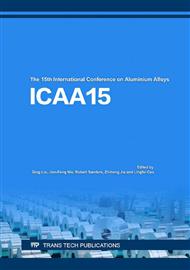[1]
W.R. Graff, D.C. Sargent, A new grain-boundary etchant for aluminum alloys, Metall. 14 (1981) 69-72.
DOI: 10.1016/0026-0800(81)90021-5
Google Scholar
[2]
S. Liu, C. Li, Y. Deng, X. Zhang, Influence of grain structure on quench sensitivity relative to localized corrosion of high strength aluminum alloy, Mater. Chem. Phys. 167 (2015) 320-329.
DOI: 10.1016/j.matchemphys.2015.10.051
Google Scholar
[3]
S.D. Liu, X.M. Zhang, M.A. Chen, Influence of aging on quench sensitivity of 7055 aluminum alloy, Mater. Charact. 59 (2008) 53-60.
DOI: 10.1016/j.matchar.2006.10.019
Google Scholar
[4]
D. Li, B. Yin, Y. Lei, S. Liu, Y. Deng, X. Zhang, Critical quenching rate for high hardness and good exfoliation corrosion, Met. Mater. Int. 22 (2016) 222-228.
DOI: 10.1007/s12540-016-5504-0
Google Scholar
[5]
Y.X. Li, P. Li, G. Zhao, The constituents in Al-10Zn-2. 5Mg-2. 5Cu aluminum alloy, Mater. Sci. Eng. A 397 (2005) 204-208.
Google Scholar
[6]
S.D. Liu, Y.B. Yuan, C.B. Li, J.H. You, X.M. Zhang, Influence of cooling rate after homogenization on microstructure and mechanical properties of aluminum alloy 7050 , Met. Mater. Int. 18(2012)679-683.
DOI: 10.1007/s12540-012-4016-9
Google Scholar
[7]
D.K. Xu, N. Birbilis, D. Lashansky, Effect of solution treatment on the corrosion behaviour of aluminium alloy AA7150: optimisation for corrosion resistance, Corros. Sci. 53 (2011) 217-225.
DOI: 10.1016/j.corsci.2010.09.015
Google Scholar
[8]
N. Birbilis, R.G. Buchheit, Electrochemcial characteristics of intermetallic phases in aluminum alloys: an experimental survey and discussion, J Electrochem. Soc. 152 (2005) 140-151.
DOI: 10.1149/1.1869984
Google Scholar
[9]
S.D. Liu, C.B. Li, Y.L. Deng, X.M. Zhang, Hardenability of high strength 7055 aluminum alloy, in: D. Scott MacKenzie (Eds. ), Proceedings of the 6th International Quenching and Control of Distortion Conference, ASM International Materials Park, Ohio, 2012, pp.889-896.
Google Scholar
[10]
S.D. Liu, B. Chen, C.B. Li , Y. Dai , Y.L. Deng, X.M. Zhang, Mechanism of low exfoliation corrosion resistance due to slow quenching in high strength aluminium alloy. Corros. Sci. 91(2015) 203-212.
DOI: 10.1016/j.corsci.2014.11.024
Google Scholar


